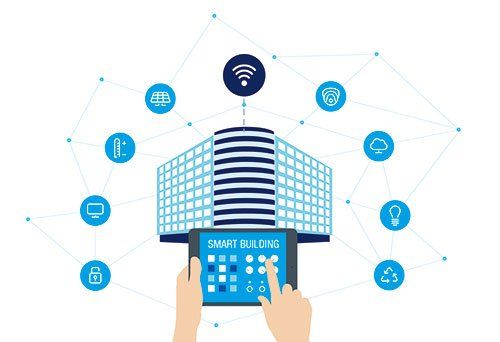A Beginner's Guide to Understanding Smart Building Technology"
Smart Buildings 101: What They Are and Why They're Here to Stay

What is a Smart Building?
A smart building is a modern building that incorporates advanced technologies to automate, optimize, and monitor its various systems and operations. It is designed to be sustainable and energy-efficient while also providing a comfortable and safe environment for its occupants. Smart buildings utilize technologies such as the Internet of Things (IoT), Building Management Systems (BMS), Building Energy Management Systems (BeMS), and Digital Twins to manage the building's energy consumption, lighting, heating, ventilation, air conditioning, security, and other systems.
The IoT plays a vital role in smart buildings by providing connectivity between devices and systems within the building. This enables real-time monitoring and control of various building systems, which helps to reduce energy waste, optimize operations, and enhance occupant comfort. BeMS and BMS automate the control of building systems, while the Digital Twin provides a virtual representation of the building, allowing for predictive maintenance and optimization of building systems.
The benefits of smart buildings include reduced energy consumption, lower operating costs, improved occupant comfort and safety, and optimized building maintenance and asset management. Overall, a smart building is an innovative and sustainable solution that improves building performance, enhances the occupant experience, and contributes to a more sustainable future.
What is the difference between a smart building and a traditional building?
The level of automation and data-driven decision making in smart buildings is what sets them apart from traditional buildings. In a traditional building, various building systems such as HVAC, lighting, and security are typically controlled manually, which can be time-consuming and inefficient. In contrast, smart buildings use advanced technologies such as BeMS, BMS, IoT, and Digital Twin to automate and optimize these systems.
Building Management Systems (BMS) and Building Energy Management Systems (BeMS) play a key role in smart buildings by controlling and optimizing various building systems, such as HVAC, lighting, and security. The Internet of Things (IoT) connects various devices and systems within the building, enabling real-time monitoring and control. Digital Twin technology creates a virtual model of the building, allowing for predictive maintenance and optimizing building performance.
Smart buildings are also designed to be more energy-efficient and sustainable, using technologies such as solar panels, rainwater harvesting, and green roofs. This reduces the building's environmental impact and lowers energy costs.
Overall, the integration of advanced technologies and sustainable features in smart buildings leads to increased efficiency, reduced energy consumption, and improved occupant comfort and safety.
How do smart buildings work?
Smart buildings work by using a combination of technologies to automate and optimize building systems. Sensors are used to collect data on various building parameters such as temperature, humidity, occupancy, and more. This data is then analyzed using data analytics and machine learning algorithms to identify patterns and trends. Based on these insights, automated systems such as Building Management Systems (BMS) and Building Energy Management Systems (BeMS) are used to adjust building systems in real-time, optimizing energy consumption and improving occupant comfort.
Artificial intelligence and cloud computing are also used to enhance the functionality of smart buildings. AI can be used to predict energy usage and identify opportunities for optimization, while cloud computing allows for the seamless integration of various building systems and data sources.
Another important aspect of smart buildings is the use of a digital twin, which is a virtual replica of the physical building. The digital twin can be used to simulate and optimize the building's operations, allowing for proactive maintenance and better overall building performance.
Overall, smart buildings use a combination of technologies to enable real-time monitoring and control of building systems, leading to improved energy efficiency, occupant comfort, and overall building performance.
What technologies are used in smart buildings?
Smart buildings incorporate a range of advanced technologies to automate, optimize, and monitor various building systems and operations. Some of the key technologies used in smart buildings include:
Internet of Things (IoT): IoT devices such as sensors and smart devices are used to collect data on various building systems, including HVAC, lighting, and security.
Building Management Systems (BMS): BMS technology is used to automate and optimize the control of various building systems, including heating, ventilation, and air conditioning (HVAC) and lighting systems
Building Energy Management Systems (BeMS): BeMS is a type of BMS that focuses specifically on managing energy consumption in buildings.
Digital Twin: A digital twin is a virtual replica of the physical building that is used to simulate and optimize building operations.
Artificial Intelligence (AI) and Machine Learning: These technologies are used to analyze data collected from sensors and other devices to optimize building operations and enhance energy efficiency.
Cloud Computing: Cloud computing technology is used to store and process large amounts of data collected from sensors and other devices.
Augmented Reality (AR): AR technology is used in smart buildings to provide visual overlays of building systems and data, enabling building operators to quickly identify and address issues.
Overall, these technologies are used in smart buildings to improve energy efficiency, optimize building systems, enhance occupant experience, and reduce operating costs. The integration of these technologies is essential for creating a truly smart building.
What are the benefits of a smart building?
There are numerous benefits of a smart building, which is a modern building that incorporates advanced technologies to automate, optimize, and monitor its various systems and operations. One of the primary benefits of a smart building is improved energy efficiency, which leads to lower operating costs. Smart buildings achieve this through the use of advanced technologies such as the Internet of Things (IoT), Building Management Systems (BMS), and Building Energy Management Systems (BeMS) that enable real-time monitoring and control of various building systems.
Smart buildings also provide a comfortable and safe environment for their occupants. Lighting, heating, ventilation, air conditioning, and security systems can be automated and optimized, providing a better experience for occupants while also reducing energy waste.
Building Automation and Proptech solutions are used to optimize building maintenance and asset management, leading to longer equipment lifecycles and reduced maintenance costs. This helps to improve the overall performance and efficiency of the building.
Overall, the benefits of a smart building include improved energy efficiency, reduced operating costs, enhanced occupant comfort and safety, and optimized building maintenance and asset management. Smart buildings are an innovative and sustainable solution that contributes to a better future.
What are some examples of smart building applications?
Smart building applications encompass a broad range of features and functionalities designed to optimize building performance, enhance occupant comfort, and improve overall efficiency. One example of a smart building application is occupancy sensing, which uses sensors to detect when people are present in a space and adjust lighting and temperature accordingly. Desk and meeting room booking systems enable employees to reserve workspaces in advance, improving collaboration and reducing wasted space. Access control systems utilize biometrics or key cards to regulate entry into buildings and specific areas, improving security and controlling occupancy. Comfort control systems allow occupants to adjust lighting and temperature to their preferences, increasing comfort and productivity.
Other smart building applications include time scheduling and optimization, which automates tasks such as cleaning and maintenance based on usage patterns and occupancy. Air quality monitoring systems can detect and alert building managers of potential indoor air quality issues. Way-finding and kiosk systems can help occupants navigate complex buildings and find resources such as meeting rooms and amenities.
Overall, smart building applications provide a wide range of benefits, including improved comfort and productivity for occupants, enhanced building efficiency, and increased security and safety.
How can a smart building improve energy efficiency?
Smart buildings can improve energy efficiency in several ways, primarily by optimizing and automating building systems through the use of advanced technologies.
Firstly, smart buildings can use sensors to collect data on building systems such as HVAC, lighting, and occupancy levels. This data is then analyzed using algorithms to identify patterns and make adjustments to optimize performance and reduce energy consumption. This can result in significant energy savings over time.
Secondly, smart buildings can use Building Management Systems (BMS) and Building Energy Management Systems (BeMS) to automate and optimize the control of various building systems, including HVAC, lighting, and security. This can improve the efficiency of these systems and reduce energy waste.
Thirdly, smart buildings can incorporate energy-efficient technologies such as solar panels, geothermal heating and cooling systems, and energy-efficient lighting. These technologies can reduce the amount of energy needed to power the building, resulting in lower energy bills and a smaller carbon footprint.
Overall, smart buildings use advanced technologies and data-driven decision making to optimize building systems and improve energy efficiency, leading to significant cost savings and a more sustainable future.
How can a smart building enhance occupant comfort and productivity?
A smart building can enhance occupant comfort and productivity in several ways. First, smart buildings use sensors and data analytics to optimize indoor air quality, temperature, and lighting conditions. This can lead to improved air quality, reduced energy consumption, and increased occupant comfort. Smart building systems can also be used to adjust temperature and lighting levels based on occupancy patterns, ensuring that spaces are always comfortable and well-lit when occupied.
In addition, smart buildings can provide occupants with greater control over their environment through mobile apps or web interfaces, allowing them to adjust temperature and lighting levels or even reserve meeting spaces. This increased control can improve occupant satisfaction and productivity, as well as promote collaboration and teamwork.
Smart buildings can also leverage advanced security systems to enhance occupant safety, such as facial recognition technology or access control systems. These systems can prevent unauthorized access and ensure that only authorized individuals are allowed into certain areas of the building.
Overall, a smart building can provide a more comfortable, productive, and secure environment for occupants, leading to increased satisfaction and better performance.
What are the security implications of a smart building?
Smart buildings can present unique security challenges due to their high degree of connectivity and automation. The various interconnected systems and devices within a smart building can provide multiple entry points for cyber-attacks, and the data collected by these systems can be valuable to hackers. For example, if a hacker gains access to the building’s HVAC system, they could potentially disrupt the building’s temperature controls, causing discomfort or even health risks to occupants.
To mitigate these risks, smart buildings must be designed with robust cybersecurity measures, including firewalls, encryption, and intrusion detection systems. Building operators must also ensure that all systems and devices within the building are regularly updated with the latest security patches and software.
Another potential security risk is physical access to the building. Smart buildings typically use access control systems that can be vulnerable to physical attacks or unauthorized access. Building operators should implement strict access control policies and protocols to ensure that only authorized individuals have access to sensitive areas.
In summary, smart buildings require strong cybersecurity measures and access control policies to ensure the safety and security of their occupants and data.
What is the future of smart buildings?
The future of smart buildings looks promising, with new technologies and innovations constantly emerging to further optimize building performance and occupant comfort. One trend that is likely to continue is the integration of artificial intelligence (AI) and machine learning into building systems. This will enable more advanced predictive analytics, allowing smart buildings to anticipate and respond to occupant needs more effectively.
Another trend is the increased use of sensors and Internet of Things (IoT) devices to gather data on building systems and occupants, allowing for more targeted and efficient control. Smart buildings may also incorporate augmented reality (AR) and virtual reality (VR) technologies to provide more immersive and interactive experiences for occupants.
In addition, the continued development of renewable energy sources and energy storage systems will enable smart buildings to become even more energy-efficient and sustainable, further reducing their environmental impact and contributing to the campaign to reach Net Zero standard by 2050. In the more immediate term, Commercial Landlord are facing challenges with ensuring their portfolio meets requirements for attaining an EPC of a minimum of E, to legally be able to rent out their commercial properties.
Also worth a mention is that those buildings offering the highest energy efficiency, highest levels of occupant comfort and functionality for tenants will also be able to charge premium rents.
So the question for building owners evaluating spend on Smart Building Technologies is not just payback against energy costs, but also the legal ability to rent, the desirability of the building to tenants, and the additional lettings value that having a state-of-the-art flagship building brings to their buildings portfolio.
Overall, the future of smart buildings is likely to be characterised by even greater levels of automation, connectivity, and sustainability, ultimately leading to more efficient and comfortable buildings for their occupants.
If you would like to find out more about opportunities in this growing market reach out to our team on
02031549422
info@crucial-people.com











